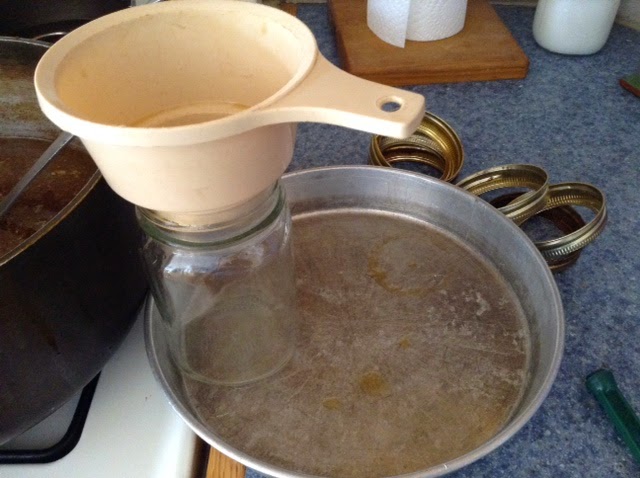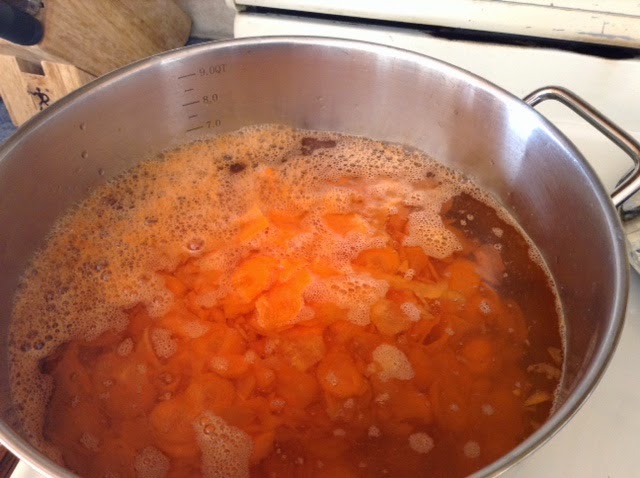Want to use ginger to make your own ginger ale or add the juice to a recipe?
I couldn't believe how simple this was!
Take a piece of ginger root - about the size of a post-it - peel off the flat areas. You could leave all the peel on, or take all the peel off. I thought taking some off would help when I strained the juice. But I definitely didn't want to take the time or loose ginger trying to peel all of it. After all I was planning to strain the juice.
Chop ginger root into to 1/2" to 1" pieces. Place in high-end blender jar. Add up to 2 cups of warm water. Run a cycle or two until completely juiced.
Strain into a jar.
Keep your concentrate in the refrigerator.
Friday, July 24, 2015
Ginger Concentrate
Labels:
Food Storage,
Health Through Diet,
Kitchen Tips
Friday, March 6, 2015
Roasted Chicken Broth - Pressure Canned
Oven roasted a chicken for Sunday lunch.
I then poured some more water, right into the roasting pan, in with the broth and bones. Added a splash of Apple Cider Vinegar to help leach the nutrients from the bones into the broth. And put the roaster with the lid on, on the wood stove to simmer.
After a day or so of simmering, I had a lovely rich, rich, brown broth.
The broth could simply have been frozen. But instead I chose to can it. Being low-acid it must be pressure canned. Our altitude requires some adjusting for. Your Pressure Canner's instructions will tell you how much you need to adjust for your altitude.
Jars and lids must be sterile and hot for a good seal.
Ladle hot broth into hot jars.
Load and then vent the canner per instructions for the particular canner you are using.
Process. Be sure to allow the pressure to fully release before opening.
Remove jars and allow them to return to room temperature. Often then need a quick wipe or wash. Label. And store in a cool, dry preferably dark room.
I then poured some more water, right into the roasting pan, in with the broth and bones. Added a splash of Apple Cider Vinegar to help leach the nutrients from the bones into the broth. And put the roaster with the lid on, on the wood stove to simmer.
After a day or so of simmering, I had a lovely rich, rich, brown broth.
The broth could simply have been frozen. But instead I chose to can it. Being low-acid it must be pressure canned. Our altitude requires some adjusting for. Your Pressure Canner's instructions will tell you how much you need to adjust for your altitude.
Jars and lids must be sterile and hot for a good seal.
 | |
| Here is a tip I learned from Grandma Ruth-put a pan under your jar to catch the drips. |
 |
| Leave the proper head-space at the top of the jar. One inch. |
Load and then vent the canner per instructions for the particular canner you are using.
Process. Be sure to allow the pressure to fully release before opening.
Remove jars and allow them to return to room temperature. Often then need a quick wipe or wash. Label. And store in a cool, dry preferably dark room.
Labels:
Food Storage,
Grandma Hatfield,
Grandma Ruth,
Kitchen Tips,
Main Dishes,
Meat,
Preserving
Wednesday, February 25, 2015
Mexican Carrots
Two years ago while visiting a friend, she treated us to "Mexican Carrots" with our lunch. Then she generously shared a copy of her recipe-which she had received from someone else.
The first summer I made a half batch and thought it would be enough for the year. No.
So last summer when the onions and carrots were ripe, I made a full batch thinking it would last the year. No again. It was gone in four months!
So when Azure Standard had a good price on organic carrots, and onions and jalapenos were on sale at the market, I decided it was time to make another batch. We enjoy this as a condiment with our Mexican meals: fajitas, tacos, burritos, and especially taco salad.
Ingredients:
5 lbs. carrots, washed, peeled, sliced on diagonal about 1/4" thick
6 large yellow onions, sliced thin
5 Tbsp olive oil
10 bayleaves
30 cloves of garlic (use more if they are small), peeled, and sliced
5 tsp whole peppercorns
3 Tbsp Mexican Oregano (there is a difference from "regular" oregano)
2 cups Apple Cider Vinegar
10 tsp sea salt
4 cups water
16 oz or about 12 average size jalapeno peppers, de-seeded and sliced.
Equipment:
Glass jars for about 1 1/2 gallons
Non-reactive 8-10 qt stock-pot and large bowl(s)
Sharp knife, mandolin, and/or slicer of some type
First, prep your carrots–wash, peel, slice. I used the large slicer cone for my Kitchen-Aid mixer and it did a wonderful job. Then bring about 5 qts of water to a boil in your stock-pot.
When water is boiling put in your carrots to blanch for only 2-3 minutes. Do not cook to soft. They are much better crunchy. At the end of the time pour off the boiling water and chill the carrots with ice water.
While carrots cool, prep the onions, garlic, peppers, and other ingredients. Again I used the thin slicer cone for my Kitchen-Aid to speed this up. The peppers I had to do by hand with a sharp chef knife.
Now, we are ready to mix our ingredients together:
Put oil and bay leaves in stock-pot. Saute until oil is infused.
Remove bay leaves. Add other ingredients in this order:
garlic and onion
peppercorns and oregano
jalapenos
Saute for a few minutes
Add vinegar, salt, water. Bring to a boil
Meanwhile put carrots in large bowl. When brine is boiling pour over carrots. Mix well. Let it cool to room temperature.
When at room temperature, scoop and pour into sterilized jar(s). Pour in all the brine to help pickle.
Place in refrigerator. I use the extra fridge in the basement. Let pickle for about 4 weeks-if you can wait that long!
The first summer I made a half batch and thought it would be enough for the year. No.
So last summer when the onions and carrots were ripe, I made a full batch thinking it would last the year. No again. It was gone in four months!
So when Azure Standard had a good price on organic carrots, and onions and jalapenos were on sale at the market, I decided it was time to make another batch. We enjoy this as a condiment with our Mexican meals: fajitas, tacos, burritos, and especially taco salad.
Ingredients:
5 lbs. carrots, washed, peeled, sliced on diagonal about 1/4" thick
6 large yellow onions, sliced thin
5 Tbsp olive oil
10 bayleaves
30 cloves of garlic (use more if they are small), peeled, and sliced
5 tsp whole peppercorns
3 Tbsp Mexican Oregano (there is a difference from "regular" oregano)
2 cups Apple Cider Vinegar
10 tsp sea salt
4 cups water
16 oz or about 12 average size jalapeno peppers, de-seeded and sliced.
Equipment:
Glass jars for about 1 1/2 gallons
Non-reactive 8-10 qt stock-pot and large bowl(s)
Sharp knife, mandolin, and/or slicer of some type
First, prep your carrots–wash, peel, slice. I used the large slicer cone for my Kitchen-Aid mixer and it did a wonderful job. Then bring about 5 qts of water to a boil in your stock-pot.
When water is boiling put in your carrots to blanch for only 2-3 minutes. Do not cook to soft. They are much better crunchy. At the end of the time pour off the boiling water and chill the carrots with ice water.
While carrots cool, prep the onions, garlic, peppers, and other ingredients. Again I used the thin slicer cone for my Kitchen-Aid to speed this up. The peppers I had to do by hand with a sharp chef knife.
Now, we are ready to mix our ingredients together:
Put oil and bay leaves in stock-pot. Saute until oil is infused.
Remove bay leaves. Add other ingredients in this order:
garlic and onion
peppercorns and oregano
jalapenos
Saute for a few minutes
Add vinegar, salt, water. Bring to a boil
Meanwhile put carrots in large bowl. When brine is boiling pour over carrots. Mix well. Let it cool to room temperature.
When at room temperature, scoop and pour into sterilized jar(s). Pour in all the brine to help pickle.
Place in refrigerator. I use the extra fridge in the basement. Let pickle for about 4 weeks-if you can wait that long!
Labels:
Cultured,
Food Storage,
Health Through Diet,
Preserving,
Veggies
Subscribe to:
Comments (Atom)


























